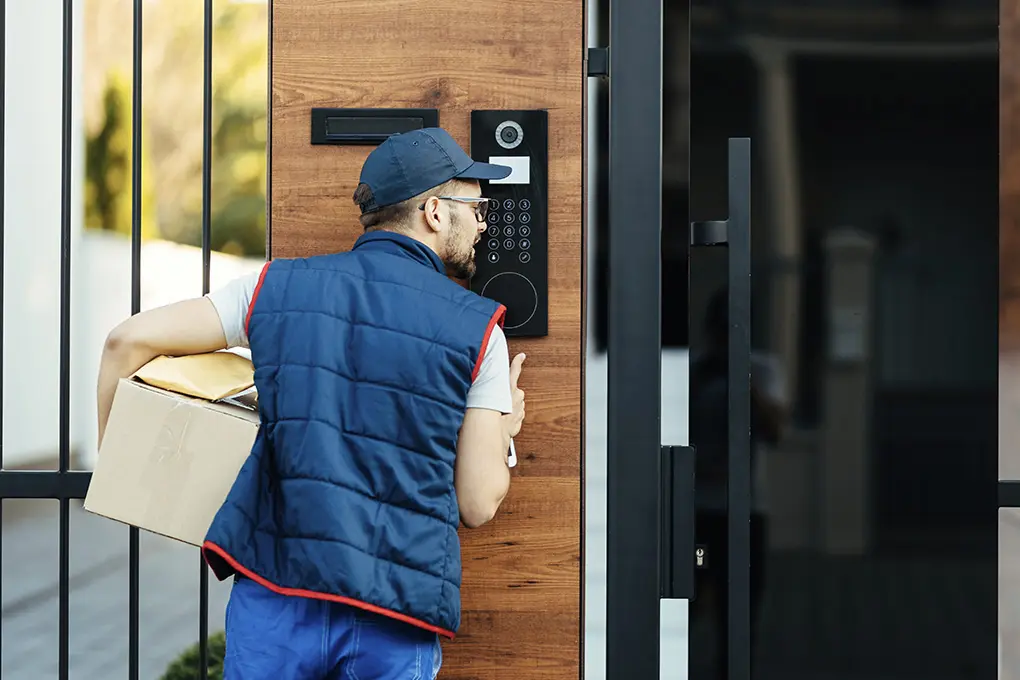Imagine coming back from a work assignment or vacation, or maybe even arriving at your second home for the season, only to find strangers living there, refusing to leave. It’s not just shocking. It’s deeply personal. Your home, your safe space, has been taken over without your consent.
Unfortunately, this isn’t just a hypothetical scenario. A rise in squatting incidents across the country has left homeowners frustrated, frightened, and sometimes powerless.
In New York City, one couple purchased a home for their disabled son, only to discover they couldn’t remove a former caretaker who had stayed beyond 30 days – protected by tenant laws despite no formal lease. In another disturbing case, a 52-year-old woman was allegedly killed after entering her deceased mother’s apartment, which had been occupied by squatters.
And it’s not just NYC. According to a National Rental Home Council survey, there were an estimated 475 squatter-occupied homes in Dallas-Fort Worth and over 100 in Orange County, Florida.
So, how can you stop this from happening to you?
Protecting your home from squatters requires preventative action, smart property management, and legal awareness. Whether you own a vacation home, rental property, or travel often, the key is making your property an unattractive target—while knowing exactly what to do if someone does move in uninvited.
In this guide, we’ll explain the practical steps you can take to keep your home secure and your ownership protected.
Table of Contents
Key Takeaways
- Squatters are more likely to target vacant, unmonitored properties
- Security systems and outdoor lighting are proven deterrents against unauthorized occupancy
- Regular check-ins and neighbor communication help show a property is actively managed
- Keeping utility records, legal paperwork, and photos creates a strong paper trail
- Swift legal action is essential once a squatter is discovered
What Are Squatters?
Squatters are individuals who occupy an abandoned, foreclosed, or unoccupied building or land without the legal right to do so. They do not own the property, pay rent, or have the owner’s permission to reside there.
Squatters may be previous tenants who have overstayed their lease, trespassers who have broken into the property, or opportunists taking advantage of a vacant home. In some cases, squatters may even present themselves as tenants, making it difficult for authorities to remove them without legal action.
It’s important to understand that squatters are not the same as trespassers. Trespassers are those who enter a property without permission but do not attempt to live there. Squatters, on the other hand, intend to reside on the property for an extended period, often exploiting legal loopholes to gain tenants’ rights.
That being said, the issue is that if squatters are in a home for long enough, they may gain some tenant-adjacent rights, depending on the state. This makes it just that much more important to act quickly once a home is occupied.

Why Is Protecting Your Home from Squatters Important?
Squatters can cause significant financial and legal headaches for homeowners. When unauthorized individuals occupy your property, they may damage the home, leading to costly repairs.
In some cases, squatters can even gain legal rights to the property if they reside there long enough, potentially resulting in a lengthy and expensive eviction process.
Protecting your home from squatters helps you maintain control over your property and avoid these potential pitfalls:
- Property Damage: Squatters often have little regard for the condition of the home they occupy, leading to neglect and damage that can be expensive to repair. Research shows that the average cost of repairs to a home following the eviction of squatters is $7,000.
- Legal Complications: If squatters establish residency, removing them can require a formal eviction process, which can be time-consuming and costly.
- Liability Risks: As the property owner, you may be held liable for any injuries or illegal activities that occur on your property, even if caused by squatters.
- Loss of Rental Income: If you own a rental property, squatters can prevent you from renting to paying tenants, resulting in lost income. For instance, a recent case of a real estate developer in Atlanta saw him lose up to $1,750 per month in lost rental income, lasting over six months. It cost this one investor $15,000 and a full six months to evict the squatters from his property.
Implementing proactive security measures and monitoring your property regularly can deter squatters and help you quickly address any unauthorized occupancy before it escalates into a more serious problem.

Squatter Rights in the U.S.: What Property Owners Need to Know
In the US, squatter rights are governed by adverse possession laws, which allow someone to claim legal ownership of the property after occupying it openly and continuously for a certain period, typically 5 to 20 years, depending on the state.
Requirements often include exclusive use, lack of permission, and sometimes, payment of property taxes.
While squatting is illegal, property owners usually can’t remove squatters without going through the civil eviction process. However, several states are changing that. Florida and Georgia now allow law enforcement to remove squatters without a court order. Texas and New York are considering or have passed laws clarifying squatters aren’t protected tenants.
Common Types of Properties Targeted by Squatters
While any unoccupied property can be a potential target for squatters, certain types of homes are more vulnerable, including vacation and seasonal homes, rental properties that are unoccupied, foreclosed properties, and abandoned buildings.
- Vacation Homes or Seasonal Residences: Properties left empty for extended periods, such as summer homes or winter cabins, are attractive to squatters due to the lack of regular monitoring.
- Rental Properties Between Tenants: During turnover or renovation periods, rental properties may be unoccupied, providing an opportunity for squatters to move in undetected.
- Foreclosed or Bank-Owned Properties: Homes that have been foreclosed or repossessed by banks can remain vacant for long periods, making them prime targets for squatters.
- Abandoned Buildings or Homes in Disrepair: Properties that appear neglected or abandoned, with overgrown yards or visible damage, can signal to squatters that the owner is absent or unlikely to notice their presence.
- Unmonitored Land or Undeveloped Areas: Squatters may set up makeshift shelters or camps on unmonitored land, such as remote rural properties or undeveloped urban lots.
Understanding which properties are most at risk can help you take targeted steps to protect your home from squatters.
If you own a vacation home, rental property, or any frequently unoccupied home, it’s especially important to implement security measures and maintain a presence to deter unauthorized occupancy.

How to Protect Your Home from Squatters
Proactively protecting your home from squatters involves a combination of physical security measures, regular monitoring, and legal preparedness. This includes securing all entry points, conducting regular property checks, installing comprehensive security, and eliminating utility access.
Here are eight effective ways to protect your property from squatters:
1. Secure All Entry Points
The first step to protect your home from squatters is to secure all potential entry points, such as doors, windows, and even skylights.
- Install high-quality, sturdy locks on all doors and windows. This includes deadbolts on exterior doors and window locks on all accessible windows.
- Pay special attention to ground-floor windows and those near fire escapes or other easy-to-reach areas.
- For sliding glass doors, add extra security with bars or locks designed specifically for these types of doors. Sliding doors can be particularly vulnerable, as they are often easier to force open than traditional doors.
- Don’t forget about other less obvious entry points, such as pet doors, garage doors, or even skylights. Consider hidden entry points burglars target and how to secure them to ensure you have all bases covered.
- Regularly inspect all locks, doors, and windows to ensure they are in proper working order. Replace any damaged or worn hardware promptly to maintain the integrity of your home’s security.
2. Perform Regular Property Checks
Regularly visiting your property is one of the most effective ways to deter squatters. Even if the home is unoccupied, frequent check-ins send a clear message that the property is actively monitored and not abandoned.
Hire Property Managers
If you live far from the property or cannot visit often, consider hiring a property management company. They can perform routine inspections, ensure the home is secure, and promptly alert you to suspicious activity.
Ask Your Neighbors
Another smart strategy is to enlist the help of trusted neighbors. Provide them with your contact information and ask them to monitor your property. They can report unusual occurrences, such as unfamiliar individuals entering the home or signs of forced entry.
How to Conduct a Property Check
When conducting property checks, look for indicators of squatting, such as:
- Broken windows or doors
- Changes to locks or security systems
- Unfamiliar vehicles parked on the property
- Accumulation of mail or newspapers
- Lights or televisions left on inside the home
If you notice any signs of unauthorized occupancy, document your findings and contact local law enforcement immediately. Swift action is key to preventing squatters from gaining a foothold on your property.
3. Install a Comprehensive Security System
A smart home security system provides an additional layer of protection against squatters. Here are some of the most essential pieces of security equipment to protect your home from squatters:
- Invest in door and window sensors that alert you to any unauthorized entry attempts.
- Security cameras, both indoor and outdoor, allow you to monitor your property remotely and gather evidence of any suspicious activity.
- Choose a security system with remote monitoring capabilities, so you can keep an eye on your home even when you’re away.
- Smart home security systems often include features like real-time alerts, live video streaming, and two-way audio, giving you greater control over your property’s security.
Selecting the Right Security System
A reliable security system can be one of your strongest lines of defense against squatters. Beyond deterring unauthorized access, it can also provide crucial documentation if legal action becomes necessary. Up to 60% of criminals who break into homes, whether for burglary or long-term squatting, are deterred by a functional home security system.
When choosing a system, keep these points in mind:
-
- Check for Insurance Incentives: Many homeowners insurance providers offer discounts for professionally monitored systems or those with smart features like smoke detectors and leak sensors. Always ask your insurer.
- Tailor It to Your Property Type: For townhouses or vacation homes, consider wireless, modular systems that are easy to install without drilling or permanent wiring, especially in shared-wall dwellings.
- Look for Smart Monitoring and Alerts: Choose systems that offer remote monitoring, mobile alerts, and video storage in the cloud. This way, you can respond to break-ins or suspicious activity even when you’re away.
- Install Strategically
-
- Place contact sensors on all accessible doors and windows
- Mount outdoor cameras at main entrances, garages, and side or backyards
- Use indoor motion detectors in hallways and common areas
- Add smart locks for keyless entry and better control over access
- Keep It Updated: Regularly test your system and install software or firmware updates. Outdated systems can have vulnerabilities that determined squatters may exploit.
- Have a Response Plan: If your system detects unauthorized entry, alert local law enforcement immediately. Also, notify your property manager or neighbors who can visually confirm activity.
A modern, well-installed security system deters squatters and helps ensure you can act quickly and decisively if a property is ever occupied unlawfully.
4. Implement Outdoor Lighting and Landscaping
Well-placed outdoor lighting and maintained landscaping create an unwelcoming environment for potential squatters.
Motion Activated Lights
Motion-activated floodlights around your property’s perimeter can startle intruders and draw attention to their presence. These lights also help you and your neighbors spot any suspicious activity, even in low-light conditions.
Landscaping Tips to Keep Squatters Away
Keep your landscaping tidy and trimmed to minimize hiding spots for squatters. Overgrown bushes, tall grass, and dense foliage provide cover for unauthorized individuals to enter and remain on your property undetected.
Pruning trees and shrubs regularly, especially near windows and doors, maintains clear sightlines and reduces potential access points.
Consider using gravel or other noisy surfaces near entry points, such as doors and windows. The distinct sound of footsteps on these surfaces can alert you or your neighbors to intruders and deter squatters from attempting to enter your home unnoticed.
Combining strategic outdoor lighting with well-maintained landscaping creates a layered approach to deterring squatters. A property that appears well-cared for and actively monitored is less likely to be targeted by those seeking to occupy homes illegally.
5. Eliminate Utility Access
Cutting off utilities in unoccupied properties is a simple yet effective way to deter squatters. Without access to water, gas, and electricity, the property becomes far less appealing as a place to live illegally.
Contact your utility providers to shut off services when your property becomes vacant. This proactive step not only makes the home less comfortable for potential squatters but also prevents unauthorized usage that could lead to costly bills.
Don’t forget to lock utility boxes and meters when shutting off utilities. Determined squatters may attempt to turn services back on, so securing these access points is essential. Use sturdy locks designed for outdoor use to withstand tampering and weather conditions.
If you’re managing a rental property, coordinate with your tenants to ensure utilities are transferred out of their name and shut off promptly when they move out. This helps avoid any gaps in service that squatters could exploit.
For properties that will be unoccupied for an extended period, such as vacation homes or seasonal rentals, consider investing in smart home technology that allows you to remotely monitor and control utilities. These systems can alert you to any unauthorized usage and enable you to quickly shut off services from anywhere.
6. Post No Trespassing Signs and Notices
Posting clear, visible “No Trespassing” and “Private Property” signs around your property’s perimeter sends a strong message to potential squatters. These signs demonstrate that the property is actively monitored and that unauthorized entry is prohibited.
Here are some tips for using signs and notices
- When placing signs, ensure they are prominently displayed at all entrances and along the property line.
- Use durable, weather-resistant materials to withstand the elements and maintain legibility over time.
- Include the property owner or manager’s contact information on the signs. This allows neighbors or passersby to report any suspicious activity directly to the responsible party.
- In addition to physical signs, consider posting notices in local newspapers or online forums, stating that the property is not abandoned and that trespassing is not permitted. This can help counter any false claims by squatters that the property is unoccupied or that they have a right to reside there.
While signs and notices alone may not completely deter determined squatters, they serve as an important legal foundation. If you need to take legal action to remove squatters, having clearly posted “No Trespassing” signs can support your case and demonstrate that the individuals were aware they were entering the property without permission.
Regularly inspect your signs and notices to ensure they remain in good condition and replace any that are damaged or missing. Consistent maintenance of these visual deterrents reinforces the message that the property is actively cared for and not a target for squatters.
7. Establish a Paper Trail
Creating and maintaining a detailed paper trail is one of the most effective ways to protect your property from squatters. It provides proof of ownership, upkeep, and ongoing involvement.
Document All Property Maintenance
Keep records of every repair, upgrade, or maintenance task you complete. Save receipts for locksmith services, security system installations, landscaping, and general upkeep. Regularly photographing or filming your property, inside and out, also helps demonstrate its condition over time.
Save Utility and Tax Records
Retain copies of all utility bills, property tax statements, and insurance policies. These show that you’re still actively managing and financially responsible for the home, even if it’s vacant.
Secure Legal Ownership Documents
Always have easy access to key documents such as the property deed, mortgage agreements, or lease contracts. These establish your legal claim to the property and may be needed in court if squatters try to contest your ownership.
Include Property Manager Reports
If you work with a property management company, keep their inspection reports and service records. Their involvement further shows that the home is actively maintained and not abandoned.
Back Up Everything Digitally
Scan all important paperwork and save it in the cloud or on a secure external drive. Digital copies ensure you can retrieve key documents remotely, especially in an emergency.
8. Take Swift Legal Action
If squatters enter your property, acting quickly is essential. The longer they remain, the harder it becomes to remove them legally. Below are steps to take to evict unlawful squatters from your home.
Contact Law Enforcement Immediately
If you suspect unauthorized occupancy, call the police. They’ll assess whether it’s a case of trespassing or if a formal eviction process is required due to the length of occupancy or claims of residency.
Serve a Legal Notice to Vacate
Issue a written notice informing the individuals they are unlawfully occupying the property. Clearly state a deadline for vacating. Be sure to comply with your state’s legal requirements regarding the format and delivery of the notice.
Begin Eviction Proceedings if Needed
If squatters don’t leave, you may need to file an unlawful detainer lawsuit or a similar legal action. Laws vary by state, so follow the proper process closely to avoid delays or complications.
Work With a Property Law Attorney
Removing squatters can get complicated. A local real estate attorney can guide you through the correct legal steps, help draft notices, and represent you in court if necessary. This ensures your rights are protected throughout the process.
Proactive Prevention Is Key
When it comes to protecting your property from squatters, prevention is far easier and far less costly than removal. Squatters often target homes that appear vacant, poorly maintained, or unmonitored.
By taking steps to make your property look occupied and cared for, you reduce the chances of it becoming a target. This includes installing a visible security system, setting lights on timers, keeping the yard tidy, and scheduling regular property check-ins if you’re away for extended periods.
It’s also important to secure all entry points with strong locks and reinforce doors and windows. If possible, enlist a trusted neighbor, friend, or property manager to keep an eye on things. Even simple signs of activity, like trash bins being moved or mail being collected, can deter would-be squatters. Staying ahead of the problem is always better than dealing with a legal battle after the fact.
Final Thoughts
Protecting your home from squatters starts with proactive action. Squatters often target vacant or unmonitored properties, which makes vacation homes, rentals between tenants, and foreclosed houses particularly vulnerable. But with the right approach, including securing entry points, installing smart security systems, maintaining regular property checks, and keeping a clear paper trail, you can dramatically reduce the risk.
Visible deterrents like motion lights and “No Trespassing” signs reinforce that a property is cared for and off-limits. And if the worst happens, swift legal action with proper documentation can make all the difference.
Ultimately, the best defense is prevention. Make your property look lived in, monitored, and protected. By taking these steps now, you can save yourself the time, cost, and stress of dealing with squatters down the road.
Keep your property safe from squatters with Batten Home Security’s expert security solutions. Explore smart locks, surveillance systems, and access control measures to protect your home today. Visit Batten Home Security to secure your property now!
Frequently Asked Questions
How Long Does It Take for a Squatter to Gain Legal Rights?
Adverse possession laws typically require 5 to 20 years of continuous occupation, depending on the state.
Can You Install Cameras Without Being on the Property?
Yes, most modern security systems support remote installation and live video access through mobile apps.
What If a Squatter Changes the Locks?
Changing locks may complicate removal. You’ll need to involve law enforcement or begin formal eviction proceedings.
Are Squatters More Active in Urban or Rural Areas?
Both are affected, but urban areas see higher cases due to housing shortages and higher vacancy rates.
Does Homeowners Insurance Cover Squatter-Related Damage?
Coverage varies. Some policies may cover vandalism or theft, but not legal costs related to eviction. Check with your insurer.
Sources
- Chart: Squatters’ Rights by State | Statista
- Squatting Map Shows Cities With Highest Number of Homes Taken Over – Newsweek
- Squatters suspected of killing woman in NYC apartment, stuffing her body in duffel bag, police sources say – CBS New York
- Counter hegemony, popular education, and resistances: A systematic literature review on the squatters’ movement – PMC
- Hidden Dangers of Squatters – Annapolis Home Concierge
- A real-estate investor says he lost over $15,000 because of squatters. ‘The rent is too damn high,’ advocates say. – MarketWatch
- Squatting poses significant risks for property owners – Business Insurance
- adverse possession | Wex | US Law | LII / Legal Information Institute
- How Home Security Systems Can Deter Squatters and Keep You Safe | US… | USNewsper




